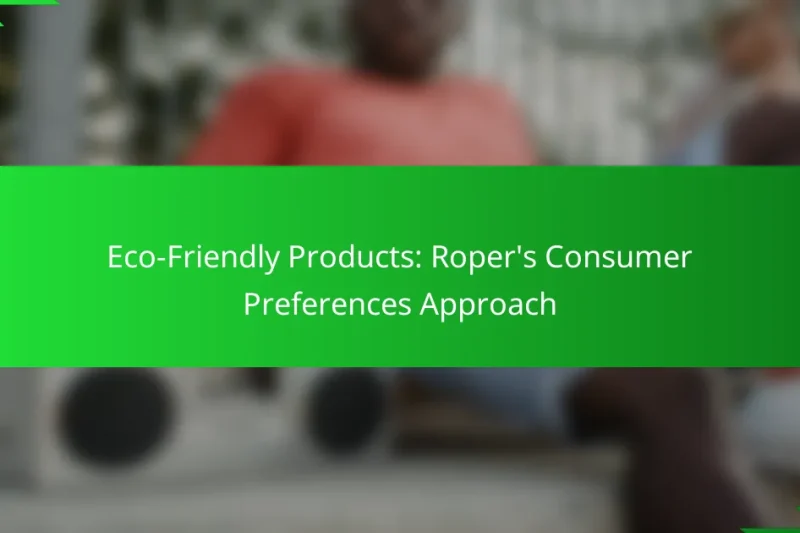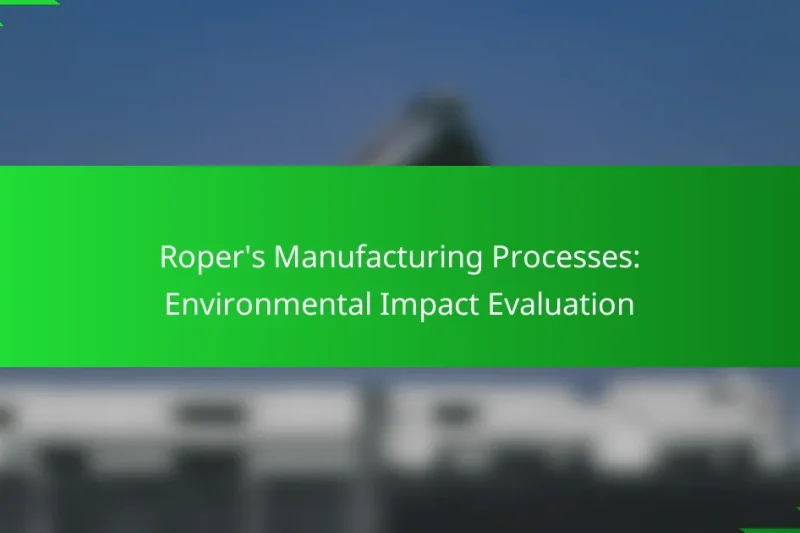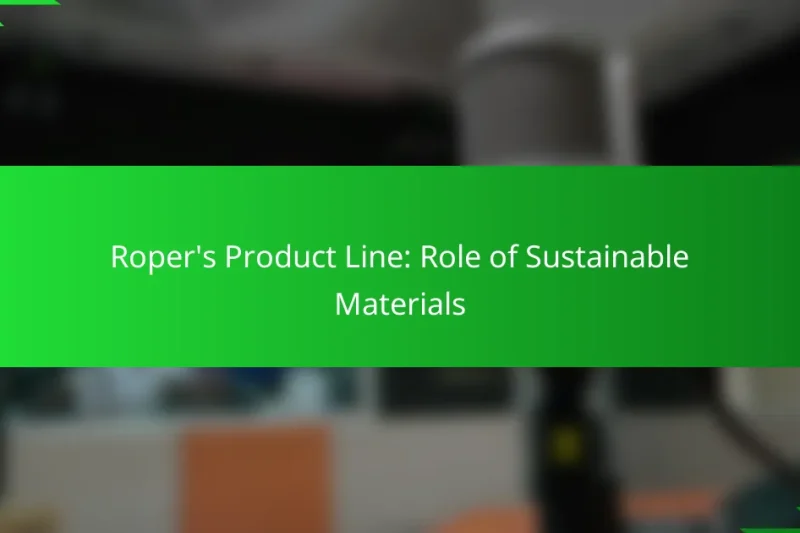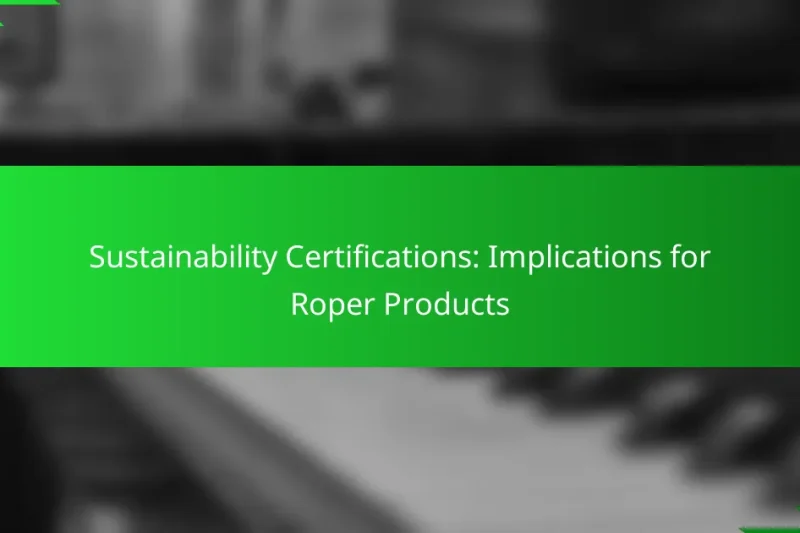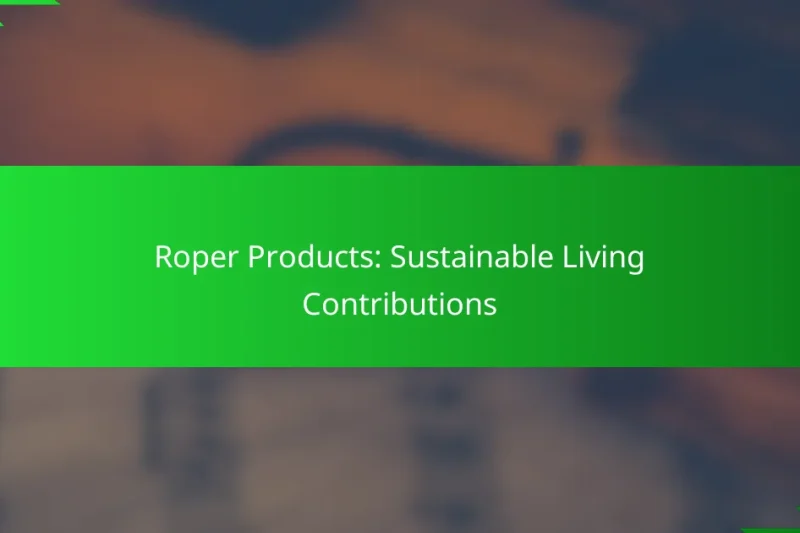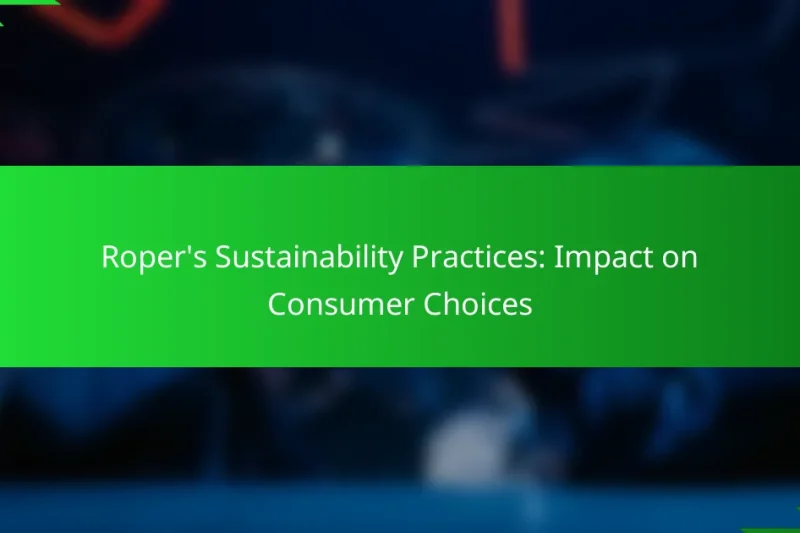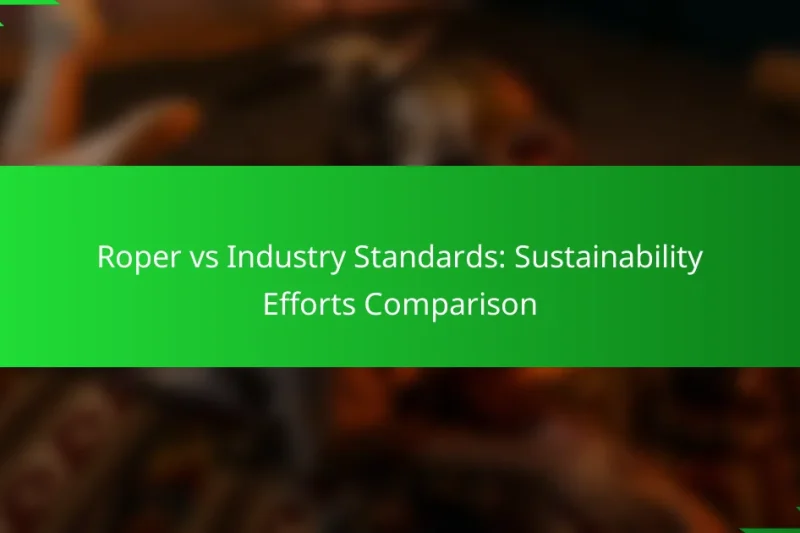As environmental awareness grows, consumers in the US are increasingly opting for eco-friendly products that reduce … Eco-Friendly Products: Roper’s Consumer Preferences ApproachRead more
Sustainability Practices at Roper Products
Roper Products is dedicated to sustainability through a range of practices designed to minimize environmental impact while ensuring high product quality. By focusing on energy-efficient manufacturing, recycled materials, and eco-friendly packaging, the company actively contributes to a healthier planet. Additionally, Roper Products evaluates the environmental impact of its offerings and seeks third-party certifications to reinforce its commitment to sustainable practices.
Roper’s Manufacturing Processes: Environmental Impact Evaluation
Roper’s manufacturing processes have a significant environmental impact, influenced by factors such as air emissions, water … Roper’s Manufacturing Processes: Environmental Impact EvaluationRead more
Roper’s Product Line: Role of Sustainable Materials
Roper is dedicated to integrating sustainable materials into its product line, utilizing recycled plastics, organic cotton, … Roper’s Product Line: Role of Sustainable MaterialsRead more
Sustainability Certifications: Implications for Roper Products
Sustainability certifications play a crucial role in enhancing Roper Products’ market position by showcasing their commitment … Sustainability Certifications: Implications for Roper ProductsRead more
Roper Products: Sustainable Living Contributions
Roper Products is dedicated to promoting sustainable living through innovative and eco-friendly practices. Their range of … Roper Products: Sustainable Living ContributionsRead more
Roper’s Sustainability Practices: Impact on Consumer Choices
Roper’s sustainability practices play a crucial role in shaping consumer choices by building trust and resonating … Roper’s Sustainability Practices: Impact on Consumer ChoicesRead more
Roper vs Industry Standards: Sustainability Efforts Comparison
Roper’s sustainability efforts reflect a commitment to reducing environmental impact and enhancing social responsibility, aligning closely … Roper vs Industry Standards: Sustainability Efforts ComparisonRead more
What sustainability practices does Roper Products implement?
Roper Products employs various sustainability practices aimed at reducing environmental impact while maintaining product quality. These practices include energy-efficient manufacturing, the use of recycled materials, water conservation, waste reduction, and eco-friendly packaging solutions.
Energy-efficient manufacturing processes
Roper Products focuses on energy-efficient manufacturing processes to minimize energy consumption and reduce greenhouse gas emissions. By utilizing advanced machinery and optimizing production schedules, the company aims to lower energy use by a significant percentage.
Implementing energy management systems helps track and improve energy performance. Regular audits ensure that energy-saving opportunities are identified and acted upon, leading to continuous improvements in efficiency.
Use of recycled materials
The company prioritizes the use of recycled materials in its product lines, which reduces the demand for virgin resources and lowers overall environmental impact. Roper Products sources materials such as recycled plastics and metals, contributing to a circular economy.
By integrating recycled content into their products, Roper not only conserves natural resources but also appeals to environmentally conscious consumers. This practice aligns with industry standards for sustainability and helps meet regulatory requirements.
Water conservation techniques
Roper Products implements water conservation techniques to reduce water usage in its manufacturing processes. This includes recycling water within production systems and using low-flow fixtures in facilities to minimize waste.
Regular monitoring of water usage allows the company to identify areas for improvement. Training employees on water-saving practices further enhances their commitment to sustainability.
Waste reduction initiatives
Waste reduction initiatives at Roper Products focus on minimizing waste generated during manufacturing and promoting recycling. The company conducts waste audits to identify key areas where waste can be reduced or repurposed.
By implementing a robust recycling program and encouraging employees to adopt waste-reducing practices, Roper aims to divert a significant portion of its waste from landfills, contributing to a more sustainable operation.
Eco-friendly packaging solutions
Roper Products is committed to using eco-friendly packaging solutions that reduce environmental impact. This includes utilizing biodegradable materials and minimizing packaging size to decrease waste.
By designing packaging that is both functional and sustainable, Roper Products not only meets customer expectations but also aligns with global sustainability trends. Continuous evaluation of packaging materials ensures that they remain compliant with environmental regulations.
How does Roper Products ensure product sustainability?
Roper Products ensures product sustainability through a comprehensive approach that includes evaluating the environmental impact of its products and obtaining third-party certifications. This commitment helps the company minimize its ecological footprint while meeting consumer expectations for sustainable practices.
Life cycle assessments
Life cycle assessments (LCAs) are critical tools that Roper Products uses to evaluate the environmental impact of its products from raw material extraction to disposal. By analyzing each stage, the company identifies opportunities to reduce energy consumption, waste, and emissions. For example, Roper may find that using recycled materials in production significantly lowers the overall carbon footprint.
Conducting LCAs involves gathering data on resource use, energy consumption, and emissions associated with each phase of a product’s life. This process allows Roper to make informed decisions that enhance sustainability and align with industry best practices.
Third-party sustainability certifications
Roper Products seeks third-party sustainability certifications to validate its environmental claims and practices. Certifications from recognized organizations provide assurance to consumers that products meet specific sustainability standards. Examples include certifications like Energy Star or the Forest Stewardship Council (FSC).
Obtaining these certifications often requires rigorous testing and adherence to strict guidelines. Roper Products benefits from this process by enhancing its credibility in the market and appealing to environmentally conscious consumers who prioritize certified sustainable products.
What are the benefits of Roper Products’ sustainability initiatives?
Roper Products’ sustainability initiatives offer multiple benefits, including environmental impact reduction, improved brand perception, and financial savings. By implementing eco-friendly practices, the company not only contributes to a healthier planet but also enhances its market position and operational efficiency.
Reduced carbon footprint
Reducing the carbon footprint is a primary goal of Roper Products’ sustainability efforts. This is achieved through energy-efficient manufacturing processes, the use of renewable energy sources, and optimized logistics that minimize transportation emissions. For example, transitioning to solar energy can significantly cut greenhouse gas emissions associated with production.
Companies can measure their carbon footprint using tools like the Greenhouse Gas Protocol, which helps identify key areas for improvement. By tracking emissions, Roper Products can set realistic targets and monitor progress over time.
Enhanced brand reputation
Roper Products’ commitment to sustainability enhances its brand reputation among consumers and stakeholders. Companies that prioritize eco-friendly practices often attract environmentally conscious customers, leading to increased loyalty and trust. This positive perception can also open doors to partnerships with other organizations that value sustainability.
To further bolster its reputation, Roper Products actively communicates its sustainability initiatives through marketing campaigns and transparency reports. Engaging with customers on social media about these efforts can amplify their impact and foster community support.
Cost savings through efficiency
Implementing sustainability initiatives can lead to significant cost savings for Roper Products. By improving energy efficiency and reducing waste, the company can lower operational costs. For instance, investing in energy-efficient machinery may have a higher upfront cost but can result in substantial savings on energy bills over time.
Additionally, adopting circular economy principles, such as recycling materials and reducing resource consumption, can further enhance financial performance. Companies should regularly assess their processes to identify areas where efficiency can be improved, ultimately leading to lower costs and increased profitability.
How does Roper Products engage with the community on sustainability?
Roper Products actively engages with the community on sustainability through various initiatives aimed at promoting environmental awareness and responsible practices. These efforts include partnerships with local organizations and educational programs designed to inform and empower community members.
Partnerships with local environmental organizations
Roper Products collaborates with local environmental organizations to enhance sustainability efforts in the community. These partnerships focus on initiatives such as habitat restoration, waste reduction, and conservation projects that benefit both the environment and local residents.
For example, Roper Products has participated in tree-planting events and clean-up drives, which not only improve local ecosystems but also foster community spirit. Engaging with these organizations allows Roper to leverage expertise and resources, maximizing the impact of their sustainability efforts.
Community education programs
Roper Products runs community education programs aimed at increasing awareness of sustainability practices. These programs offer workshops and seminars that cover topics such as recycling, energy efficiency, and sustainable living practices.
By providing hands-on learning experiences, Roper helps community members understand how they can contribute to sustainability in their daily lives. These initiatives often include practical tips and resources, making it easier for individuals and families to adopt eco-friendly habits.
What criteria should consumers consider when evaluating sustainable products?
Consumers should consider material sourcing, manufacturing practices, and product lifecycle when evaluating sustainable products. These criteria help determine the environmental impact and ethical considerations associated with a product.
Material sourcing
Material sourcing involves assessing where and how the raw materials for a product are obtained. Look for products made from renewable resources, recycled materials, or sustainably harvested materials. Certifications such as FSC (Forest Stewardship Council) for wood products can indicate responsible sourcing practices.
Additionally, consider the carbon footprint associated with transporting materials. Local sourcing can reduce emissions and support regional economies. Always check for transparency in the supply chain to ensure ethical practices.
Manufacturing practices
Manufacturing practices refer to the processes used to create a product and their environmental impact. Sustainable manufacturing often includes energy-efficient processes, waste reduction strategies, and the use of non-toxic materials. Companies that adhere to ISO 14001 standards demonstrate a commitment to environmental management.
When evaluating manufacturing, consider the use of renewable energy sources, such as solar or wind power, in production facilities. Also, check if the company has initiatives for minimizing water usage and reducing emissions during production. Understanding these practices can guide consumers toward more responsible purchasing decisions.
